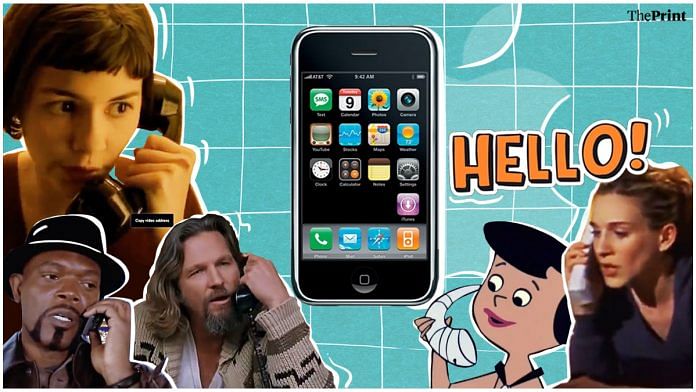New Delhi: Like each year, the 79th Academy Awards on 25 February, 2007 were special. But when Leonardo DiCaprio’s ‘The Departed’ was announced as the Best Picture, there was something else on television screens that caught the viewer’s attention.
A teaser advertisement where a rotary dial telephone rings and a series of different movie and TV show characters say ‘HELLO’. At the end of the commercial came a mobile phone with an Apple logo – without any keypad — and a tagline that said ‘Coming in June’.
It was Apple’s marketing campaign for its first ever iPhone. The advertisement featured clips from over 30 different movies and TV shows, including ‘The Fugitive’, ‘The Incredibles’ and ‘American Graffiti’.
The first iPhone, or iPhone 1, was launched for $499 in 2007. Today, an iPhone 13 is priced at least $ 999. Apple, which became the first three trillion dollar company in the US in January this year, was then valued at around $174 billion.
Much has changed from Apple founder Steve Jobs’-era to current CEO Tim Cook’s. Arun Singh, an engineer by profession, said, “It was exciting to see a full screen mobile phone. We never thought we could do away with the keyboard completely. When the teaser for iPhone came, I remember there were already a lot of rumours and hype going on about an Apple phone.”
The advertising agency leading Apple’s creative campaign for its first iPhone was TBWA/Chiat/Day. It has been associated with Apple for a long time.
What made the product very unique was the fact that it was a smartphone without any keyboard. All smartphones had keyboards back then, which took a lot of space, and were difficult to type on. The concept of ‘touch phones’ was still not as popular.
‘Combination of three revolutionary products’
Jobs introduced the first iPhone as a combination of three revolutionary products. A marketing and tech genius, Jobs, while interacting with his audience, said, “This is a day I’ve been looking forward to for two and a half years. Every once in a while a revolutionary product comes along that changes everything. In 1984,we introduced the Macintosh and changed the whole computer industry. In 2001, we introduced the first iPod and changed the entire music industry.”
“Well, today we’re introducing three revolutionary products of this class. The first one is a widescreen iPod with touch controls. The second is a revolutionary mobile phone. The third is a breakthrough Internet communications device.”
He went on to say that these are not three separate devices but one single device called the iPhone. And the crowd cheered with thundering claps and shouts.
“Its highly-touted feature is a 3.5-inch, touch-sensitive screen that consumers use to make calls, navigate their music collection, and write messages on a virtual onscreen keyboard,” noted a case study by the Augustana College.
While touch-to-call might be a basic feature today to dial a friend or family member, at the time it was seen as ‘revolutionary’.
“iPhone is a revolutionary new mobile phone that allows users to make calls by simply pointing at a name or number,” Apple had said in a statement, and added that the “stunning” phone also had “a 2 megapixel camera and a photo management application that is far beyond anything on a phone today”.
Jobs had rightly called the first iPhone “years ahead of other mobile phones”. Many of the basic features in today’s phones were first introduced by Apple in 2007. It revolutionised the telecommunications industry and left behind many competitors – like Nokia and Blackberry.
Also read: The fake ‘Rohan Rathore’ rumours around ‘Emptiness’, millennials’ go-to breakup song



